|
 The first thing I like to do when starting a project using a Boley cab and chassis is to disassemble it removing anything I don’t plan to use while making room for items to be added such as fuel tanks, crossover steps, toolboxes, hydraulic tanks and bumpers. Chassis length needs to be determined at this point. Most major cab and chassis manufacturers offer prototypical model lengths on their web sites. Doing a little homework online can help make a more realistic model while avoiding some headaches during the build. With a couple of math conversions you can have an exact wheelbase and cab to axle measurement. Depending on the model cab you are working with it may necessary to shorten or lengthen the chassis. Shortening the chassis can be done with a sharp hobby knife or saw. Lengthening it will require the addition of some styrene channel. I found the need to lengthen the Boley chassis by 1/8”. This will add enough room for the grapple to swing and the dump box to rotate without contacting each other. A cut through the chassis was made underneath the cab. Gussets were then added to the inside of the frame rails for additional support. The frame is a part of the model that is rarely looked at or seen on a prototype truck so I don’t dwell on this stage very long. The cab, dump box and crane mount will hide the majority of the frame. There is only a small section of chassis that will be seen between the crane mount and Roto Dump box; that is the section that will need some primping with a file or some sandpaper. The first thing I like to do when starting a project using a Boley cab and chassis is to disassemble it removing anything I don’t plan to use while making room for items to be added such as fuel tanks, crossover steps, toolboxes, hydraulic tanks and bumpers. Chassis length needs to be determined at this point. Most major cab and chassis manufacturers offer prototypical model lengths on their web sites. Doing a little homework online can help make a more realistic model while avoiding some headaches during the build. With a couple of math conversions you can have an exact wheelbase and cab to axle measurement. Depending on the model cab you are working with it may necessary to shorten or lengthen the chassis. Shortening the chassis can be done with a sharp hobby knife or saw. Lengthening it will require the addition of some styrene channel. I found the need to lengthen the Boley chassis by 1/8”. This will add enough room for the grapple to swing and the dump box to rotate without contacting each other. A cut through the chassis was made underneath the cab. Gussets were then added to the inside of the frame rails for additional support. The frame is a part of the model that is rarely looked at or seen on a prototype truck so I don’t dwell on this stage very long. The cab, dump box and crane mount will hide the majority of the frame. There is only a small section of chassis that will be seen between the crane mount and Roto Dump box; that is the section that will need some primping with a file or some sandpaper.
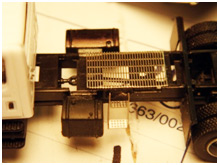 Within this section of the chassis it was decided to add an additional fuel and hydraulic tank, stainless steel steps, toolbox and mesh walkway surface (shown in photo at right). Sheet styrene and angle pieces painted black make the mud flaps for the rear axles. Within this section of the chassis it was decided to add an additional fuel and hydraulic tank, stainless steel steps, toolbox and mesh walkway surface (shown in photo at right). Sheet styrene and angle pieces painted black make the mud flaps for the rear axles.
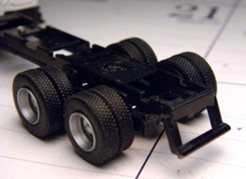 The ends of the frame rails are different on a Roto Dump chassis. By eliminating the Boley frame rail ends and adding the rear frame member from the gravel trailer, it will become more prototypical. The ends of the frame rails are different on a Roto Dump chassis. By eliminating the Boley frame rail ends and adding the rear frame member from the gravel trailer, it will become more prototypical.
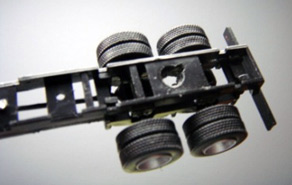 Enlarging the screw hole diameter and adding a key way allows the kingpin upper plate from the gravel trailer to fit in. This will allow the dump box to be locked to the chassis while being rotational. Enlarging the screw hole diameter and adding a key way allows the kingpin upper plate from the gravel trailer to fit in. This will allow the dump box to be locked to the chassis while being rotational.
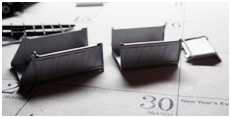 Using the miter saw and miter box, cut the gravel trailer at the seams leaving enough styrene at the bulkhead to file down for a perfect fit against the rear dump section. In order to avoid any possible damage to the tailgate, it was removed for this step. Using the miter saw and miter box, cut the gravel trailer at the seams leaving enough styrene at the bulkhead to file down for a perfect fit against the rear dump section. In order to avoid any possible damage to the tailgate, it was removed for this step.
 This picture shows the dump box with kingpin filed and ready to be mounted on the underside of the dump box frame (between the frame rails). The rest of the parts make up the bone pile [Editor's note: "bone pile" refers to the leftover parts]. Some of the parts will be scavenged later. Personally I prefer to use the stock Boley wheels or Dennis Aust wheels and rims. For this model build I chose to stick with the stock Boley wheels and rims. This picture shows the dump box with kingpin filed and ready to be mounted on the underside of the dump box frame (between the frame rails). The rest of the parts make up the bone pile [Editor's note: "bone pile" refers to the leftover parts]. Some of the parts will be scavenged later. Personally I prefer to use the stock Boley wheels or Dennis Aust wheels and rims. For this model build I chose to stick with the stock Boley wheels and rims.
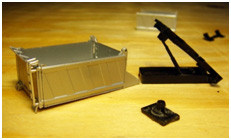 This picture shows the bulkhead mounted to the rear half of the gravel trailer. The rear discharge chute has been cut and filed down half way based on the prototype. The dump box frame hoist is cut down to match the new dump box dimensions. The kingpin plate off of the trailer is shown filed down to fit between the frame rails of the hoist. It will need to be significantly thinner to fit. This picture shows the bulkhead mounted to the rear half of the gravel trailer. The rear discharge chute has been cut and filed down half way based on the prototype. The dump box frame hoist is cut down to match the new dump box dimensions. The kingpin plate off of the trailer is shown filed down to fit between the frame rails of the hoist. It will need to be significantly thinner to fit.
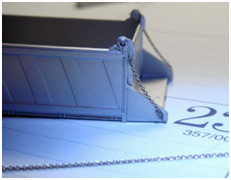 The chain will simulate the prototype’s adjustable rear discharge chute. The chains allow the operator to adjust the discharge chute when dumping the load. The chain will simulate the prototype’s adjustable rear discharge chute. The chains allow the operator to adjust the discharge chute when dumping the load.
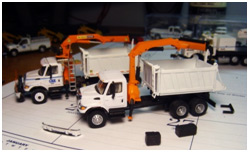 This picture shows the body and crane being test fit to identify any clearance issues early on in the build. The crane support arm has been added to the tailgate to support the crane arm when in the stowed position. The kingpin can now be permanently glued to the dump body frame once the box has been test fit for clearance. This picture shows the body and crane being test fit to identify any clearance issues early on in the build. The crane support arm has been added to the tailgate to support the crane arm when in the stowed position. The kingpin can now be permanently glued to the dump body frame once the box has been test fit for clearance.
Continued on page 3
Quick Link To Page # - 1 2 3 4 5 |